
Willows, also called sallows and osiers, of the genus Salix, comprise around 350 species of typically deciduous trees and shrubs, found primarily on moist soils in cold and temperate regions.

Bearberries are three species of dwarf shrubs in the genus Arctostaphylos. Unlike the other species of Arctostaphylos, they are adapted to Arctic and subarctic climates, and have a circumpolar distribution in northern North America, Asia and Europe.

Arctostaphylos is a genus of plants comprising the manzanitas and bearberries. There are about 60 species of Arctostaphylos, ranging from ground-hugging arctic, coastal, and mountain shrub to small trees up to 6 m tall. Most are evergreen, with small oval leaves 1–7 cm long, arranged spirally on the stems. The flowers are bell-shaped, white or pale pink, and borne in small clusters of 2–20 together; flowering is in the spring. The fruit are small berries, ripening in the summer or autumn. The berries of some species are edible.

Salix alba, the white willow, is a species of willow native to Europe and western and central Asia. The name derives from the white tone to the undersides of the leaves.

Salix purpurea, the purple willow, purpleosier willow, or purple osier, is a species of willow native to most of Europe and western Asia north to the British Isles, Poland, and the Baltic States.

Arctostaphylos uva-ursi is a plant species of the genus Arctostaphylos widely distributed across circumboreal regions of the subarctic Northern Hemisphere. Kinnikinnick is a common name in Canada and the United States. Growing up to 30 centimetres in height, the leaves are evergreen. The flowers are white to pink and the fruit is a red berry.
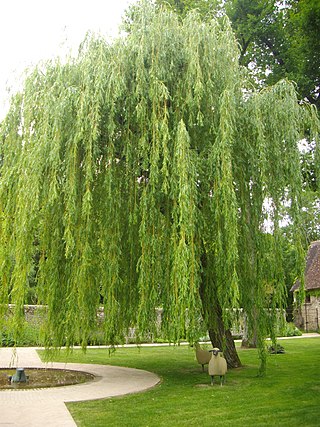
Salix babylonica is a species of willow native to dry areas of northern China, but cultivated for millennia elsewhere in Asia, being traded along the Silk Road to southwest Asia and Europe.
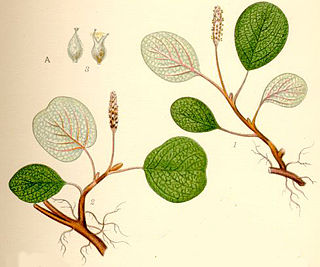
Salix reticulata, the net-leaved willow, or snow willow, is a dwarf willow, native to the colder parts of Europe, North America, and Northern Asia. It is found in the western United States, including the Sierra Nevada and Rocky Mountains. In Europe it extends south through the Carpathian Mountains and Alps to the Pyrenees and the mountains of Bulgaria and North Macedonia. It is common in Canada, Greenland and Finland, and present but rare in Scotland.

Salix integra is a species of willow native to north-eastern China, Japan, Korea and the far south-eastern Russia.

Vaccinium crassifolium, the creeping blueberry, is a species of Vaccinium in the heath family. It is native to the four southeastern U.S. states of Virginia, North Carolina, South Carolina, and Georgia. It is an evergreen shrub with shiny dark green to bronze leaves.
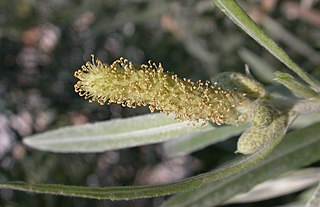
Salix exigua is a species of willow native to most of North America except for the southeast and far north, occurring from Alaska east to New Brunswick, and south to northern Mexico. It is considered a threatened species in Massachusetts while in Connecticut, Maryland, and New Hampshire it is considered endangered.
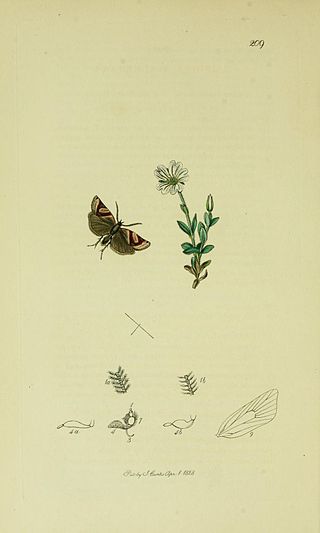
Philedonides lunana, also known as the heath tortrix and Walker’s Lanark tortrix, is a moth of the family Tortricidae. It was first described by Carl Peter Thunberg in 1784 and is found in most of Europe.
Kinnikinnick is a Native American and First Nations herbal smoking mixture, made from a traditional combination of leaves or barks. Recipes for the mixture vary, as do the uses, from social, to spiritual to medicinal.
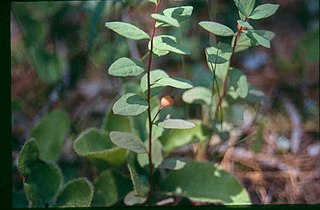
Geocaulon is a monotypic genus of flowering plants in the family Santalaceae containing the single species Geocaulon lividum, which is known by the common names northern comandra and false toadflax. It is native to northern North America, where it is common and widespread from Alaska to Newfoundland and into the northernmost contiguous United States.

Arctous is a genus of plants referred to by the common name "bearberry", a name sometimes shared with certain species of the related genus Arctostaphylos, in particular, A. uva-ursi. Although the two genera are related, certain characters, such as deciduous, marcescent leaves, rugose-reticulate venation, and finely-toothed leaves are more typical of Arctous than Arctostaphylos.
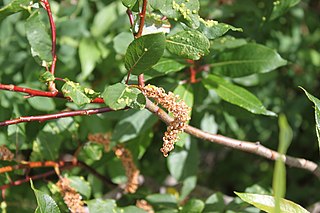
Salix pyrifolia, the balsam willow, is a species of flowering plant in the family Salicaceae, native to Canada, and the north-central to northeastern United States. A shrub, its leaves emit a balsam-like fragrance. It is available from commercial suppliers.
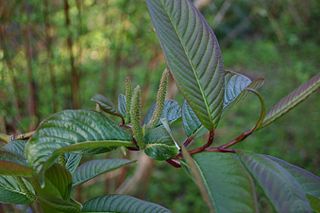
Salix moupinensis, the Moupin willow, is a species of flowering plant in the family Salicaceae, native to western Sichuan and northern Yunnan, China. It resembles Salix fargesii and is available from commercial suppliers.
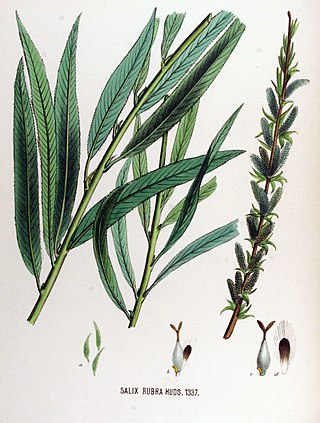
Salix × rubra, the green-leaved willow or red osier, is a naturally occurring hybrid species of flowering plant in the family Salicaceae. It is the result of crosses between Salix purpurea and Salix viminalis. It is native to a large part of Europe, found where the parent species' ranges overlap. The straight, flexible stems are prized by basketmakers. There are a number of cultivars, with the fastigiate 'Eugenei' being the best known.
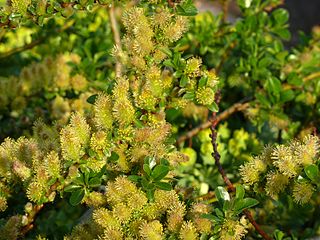
Salix apoda, the Caucasian willow, is a species of flowering plant in the family Salicaceae, native to the Caucasus and northern Turkey. A prostrate shrub, it is occasionally cultivated as an ornamental ground cover in rock gardens, particularly the males, since they produce large, silvery catkins that then erupt in yellow stamens.



















